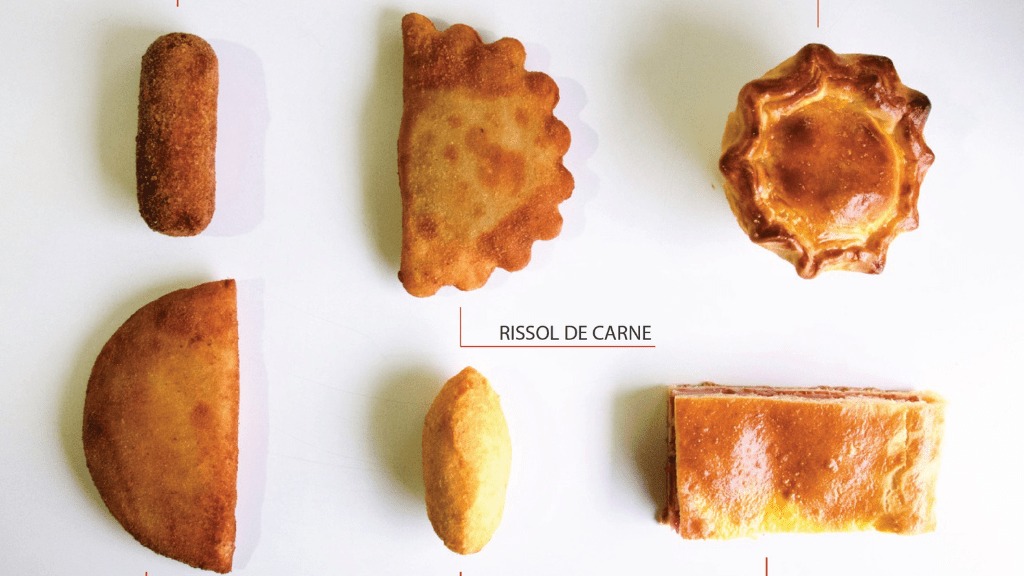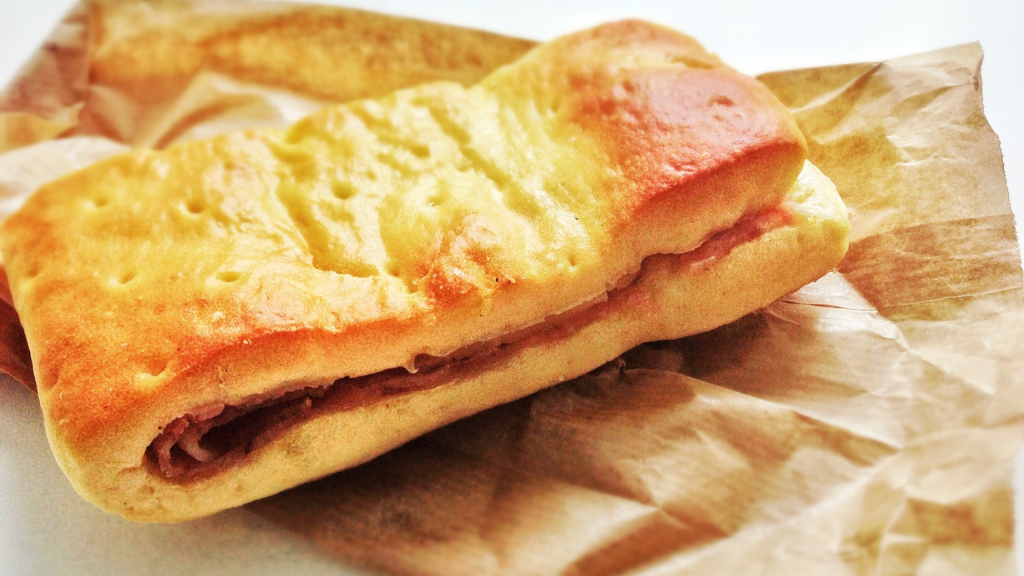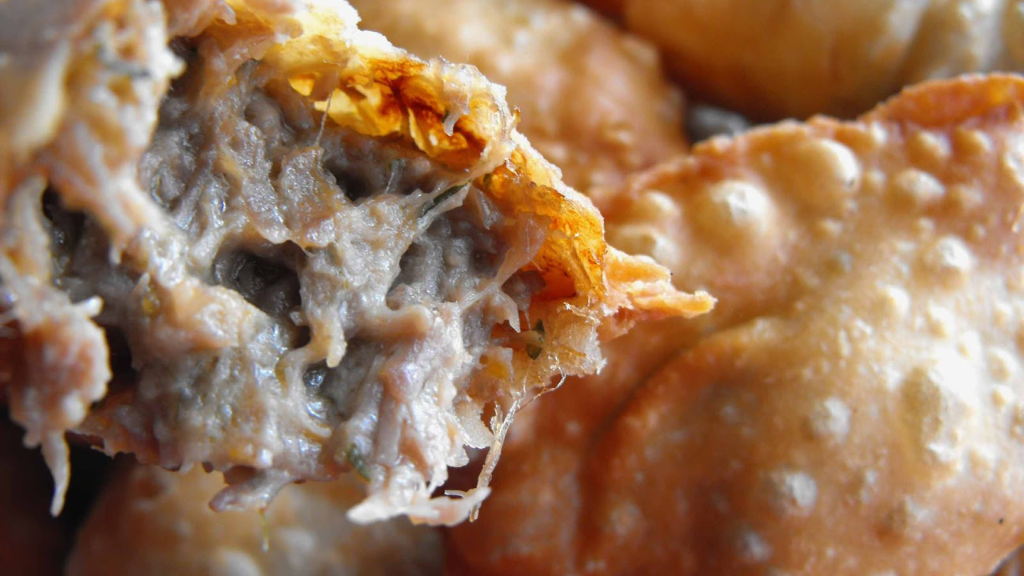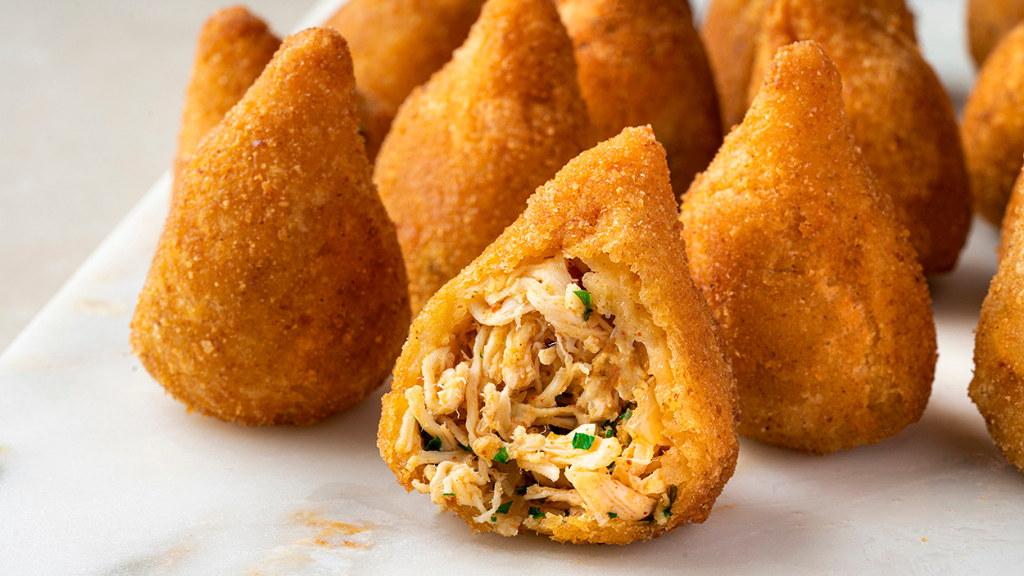Must-try Portuguese savory snacks (that aren’t cod fritters)

To talk about savory snacks in Portugal is almost immediately synonymous with speaking about cod fritters. Indeed pastéis de bacalhau, aka cod cakes, are one of our most well-liked snacks. But they certainly aren’t the only ones.

In Portugal, we eat savories known as salgados in between meals, as appetizers and, sometimes, when we include side dishes like rice and/or salad, even as a main meal.
Visit your run of the mill corner café or pastelaria, and you will notice a variety of savory snacks on the counter. In this context, savories are ordered per unit and usually eaten at room temperature. It’s only when we eat them in actual restaurants, where they are fried to order or heated up, and eventually eaten warm.
Today we thought we’d share with you other savory snacks typical in Portugal, apart from the most commonly known ones made with salted cod. To begin with, it’d be relevant to note that, even within the realm of bacalhau, there are at least two different recipes which are common. On one hand we have the one which is the most popular with tourists and locals alike, pastéis de bacalhau, which consist of oval shaped fritters made with a batter prepared with shredded salt cod, mashed potatoes, onions and parsley. These are fried until crispy on the outside but, mostly thanks to the starch of the potato, very smooth on the inside. Besides these pastéis (which are known as bolinhos de bacalhau in the north of the country), there are also pataniscas, which are flat cod fritters prepared with a flour batter instead of potato. Pataniscas are also one of the most typical salted cod dishes in Portugal, but they aren’t as ubiquitous as pastéis de bacalhau. In fact, we are more likely to eat pataniscas as part of a main meal with “naughty rice”, than simply as a quick snack.
Cod aside, the Portuguese range of salgados includes other specialities prepared with chicken, meat, cheese and more. These are the best savory snacks you should try in Portugal.

Most popular Portuguese fritters
Even though many of the following have been influenced by different cuisines from around the world, or have resulted from a slow evolution of methods of cooking over the centuries, these are some of the most common fritters and savory snacks you will find across Portugal:
Croquetes | meat croquettes
There are several countries that make dumplings which go by the name of croquettes. These are usually breaded and deep-fried snacks, more often than not, prepared with meat. Classical Portuguese croquetes are dark brown and cylindrical. These are traditionally prepared with beef or a mix of beef and pork, and they are fairly similar to the Dutch-style beef croquettes. Unlike Spanish ones, for example, they do not have a bechamel rich oozy filling. Portuguese croquetes are dense, meaty, and you shouldn’t be surprised to find strings of pulled meat in between bites of moderately creamy filling. When you order a croquete in a regular café, you’d usually eat it plain and at room temperature. In a tavern or restaurant, when you eat croquetes as a petisco or appetizer, you may get a dipping sauce, ordinarily mustard.
While classical tube shaped croquetes still dominate the counters of typical Portuguese pastelarias, contemporary versions of croquetes are becoming more and more frequent. Interestingly, these newer flavors present not only different base ingredients, but also a round shape, which distinguishes them from the traditional fritters. Now-a-days we find croquetes made out of Portuguese cured sausages such as farinheira or alheira, either on their own or as added flavors for the usual meat, as well as seafood like salted cod (not to be mistaken with pastéis de bacalhau, as the croquetes contain milk instead of mashed potatoes), cuttlefish, tuna, and more. Croqueteria inside Time Out Market in Lisbon would be a good place to let your taste buds expand their concept of classic meat croquette, aka, croquete de carne. But if you’d rather focus on the classical recipe instead, grab a seat by the counter at Restaurante Gambrinus, order a croquete, dip it in English mustard, and enjoy one of the quintessential foodie experiences you ought to have in Lisbon – trust us on this one, as Gambrinus croquetes have almost reached mythical status in the city.

Rissóis | turnovers
These half-moon shaped turnovers are Portugal’s adaptation of the French rissoles. The standard rissol filling in Portugal differs from those in France. Portuguese rissóis are traditionally stuffed with minced beef (rissóis de carne), shrimp bechamel (rissóis de camarao), or shredded fish (rissóis de peixe). The dough for rissóis is prepared with wheat flour and butter, or margarine, worked until it becomes stretchy enough to be able to shape your turnovers. After filling them and closing them similarly to a Spanish or Latin American empanada, rissóis are breaded and deep-fried. These turnovers are incredibly versatile and you could virtually stuff them with anything that you’ve got in hand. If the most classical rissóis include beef or shrimp (these are the ones you’re most likely to find in pastelaria counters), other rissóis which Portuguese folks tend to love include suckling pig (rissóis de leitão, such as the ones by Afonso dos Leitões), salted cod (rissóis de bacalhau), chicken (rissóis de frango), and even vegetarian versions (rissóis de legumes) such as those crafted by A Minha Avó or Vegatalho.
If you wish to immerse yourself in the world of Portuguese salgados while in Lisbon, you could visit Beira Gare (Praça Dom João da Câmara 4), an unpretentious snack-bar right next to Rossio’s train station, on your way to or way back from Sintra, where they have good rissóis and other fritters. For a fancier take on rissóis, try the cockle turnovers (rissóis de berbigão) served at Taberna Albricoque.

Empadas | pies
We could trace the origin or savory pies to more than 2500 years ago. Originally, pie dough was prepared as a sort of wrapper to protect the more prized ingredients that were hidden inside a pie. Ancient Egyptians were already preparing their own version of pies and it was a few centuries later, around the 5th century BC, when the Greeks are believed to have invented pie pastry, similar to the one we still use today. Originally, pie fillings weren’t minced or easy to directly bite on like they are now-a-days. Medieval pies, for instance, customarily featured full chunks of birds and other cuts of meat. In Portugal, pies are believed to have been introduced by the Romans, during the time the Portuguese territory belonged to the Roman Empire about 2000 years ago.
To speak of a Portuguese pie now-a-days in our country is almost synonymous with referring to a chicken pie, that is, an empada de galinha. Of course pies can be made with different types of pastry and fillings, but the classical Portuguese chicken pies are small and for individual consumption (in juxtaposition with their former ancient versions which were large). These are prepared with a wheat dough with a fairly high fat content, and shredded seasoned chicken as a filling. Interestingly, in Portugal, empadas de galinha are highly linked to catholic customs. Chicken became the most common filling for empadas because of the church’s mandate to fast on fridays. Even though you wouldn’t be allowed to consume meat on these days, curiously chicken wasn’t considered to be meat. Today, not only the thicker shortcrust style of pastry can be substituted for puff pastry, empada fillings can also vary and include mixed cured meats, minced beef, pork and/or vegetables. Besides the regular chicken pies you will find in many establishments across the country (for example Salsa & Coentros), while in Lisbon, we’d highly encourage you to try the empada de cozido, with a filling of the ingredients used for Portugal’s national dish, cozido à portuguesa, in restaurants like Belmiro. Other notable savory pies you can taste in Lisbon include the one made with salted cod by A Empadaria Alentejana, the pork cheeks empada by Alentejo style eatery O Frade, or any of the flavors featured as part of Empadologia LAB’s large range.
Pão com chouriço | chorizo stuffed bread
Not all savories need to be deep-fried! There are many occasions which a nostalgia addicted Portuguese person could associate with pão com chouriço. For some of us, it could transport us to recess during school days. For others, this is the taste of outdoor summer festivities back in the village where they grew up. For many, pão com chouriço and a comforting bowl of caldo verde soup is synonymous with hungover (or hungover preventing) food in the late night or early morning hours, after partying away. These bread buns are baked with slices of chorizo on the inside, and are sold in regular bakeries and pastry shops, in food trucks which will often include a portable wood oven to make them taste traditional, and even on dedicated businesses such as A Merendeira, which is open almost 24/7 in Lisbon’s Av. 24 de Julho.
Pão com chouriço consists of white soft dough prepared with high hydration, with smoked and cured Portuguese smoked sausage chouriço on the inside. Even though the recipe is believed to have originated in Marco de Canaveses, in the municipality of Porto, you can easily find pão com chouriço all over Portugal.

Merenda mista or lanche | milky bread with ham & cheese
Merendas or lanches, as they are more commonly referred to in the north of Portugal, are sweet(ish) brioche pockets stuffed with either ham and cheese (misto) or even with these two ingredients plus thin slices of chourição, that is, the thicker cousin of Portuguese cured sausage chouriço. As the dough is baked already stuffed with these cuts, the cheese ends up melting and acting as a sort of bond between the meats. Unless you visit a bakery during production hours, most commonly during the night, you’d rarely get to eat a merenda warm. Merendas mistas are eaten at room temperature and are an ideal snack when you’re not sure if you’re craving a sandwich or a savory snack, as they are sort of like the hybrid of both these foods!
Merenda and lanche are two Portuguese words which refer to a small meal closer to a snack, which is usually eaten in between main meal times, particularly in the afternoon. This would be the equivalent to merienda in Spain, afternoon tea in England, or fika in Sweden. As such, the name of this snack clearly indicates the purpose its creators had in mind when they came up with it. Many pastelarias all over Portugal carry merendas and variations include folhado misto, which replaces the rich milky dough for puff pastry. If you prefer the puff pastry variety, you may also want to keep an eye out for folhado de salsicha, that is sausages wrapped in puff pastry.

Pastéis de massa tenra | fried meat pockets
Thanks to its usual half moon shape, and even though they can sometimes also be shaped as a square or rectangle, pastéis de massa tenra (note that pastéis is plural for pastel) may resemble rissóis at a first glance. The first difference is that, unlike rissóis, pastéis de massa tenra aren’t breaded. These fried pockets can be traced back to at least the 18th century. While nowadays there are stuffing variations such as those with vegetables, a classic pastel de massa tenra is filled with a creamy concoction of minced beef sauteed with onions, garlic, bay leaf, salt, pepper and nutmeg. The creaminess of the filling is a direct result of what happens when you take the meat from the heat: you add egg yolks, lemon juice and chopped parsley. These are similar to Latinamerican empanadas, yet the dough is prepared with wheat flour, water, salt, olive oil and, for extra flavor, a little pork lard too.
In Lisbon, fruit shop and snack-bar Frutalmeidas (with locations in Av. de Roma and Saldanha) has iconic pastéis de massa tenra, said to not only be the best in Lisbon but in the country. But there are other establishments whose efforts shine through in a very tasty manner, including Pap’Açorda, which happens to be one of our favorite restaurants in the city and a good place to try not only pastéis de massa tenra but also many other Portuguese delicacies!

Regional savory snacks from across Portugal
Not as usual as the ones above, there are regional snacks which you will probably have to travel away from Lisbon to try. Unless you’re visiting a specific restaurant or a themed food fair, the following savories are most commonly found in and around their place of origin.

Pastel de Chaves | minced meat puff from Chaves
Lovers of savory puff pastry will go wild for pastel de Chaves, an extremely flaky laminated half-moon pocket filled with minced meat, typical from the city of Chaves in Trás-os-Montes. Pastel de Chaves is so representative of the cuisine of this region that it has gained PGI status, that is, a protected geographical indication label. This golden layered pocket is filled with well-seasoned minced veal. While the top of the dough becomes golden after being baked in the oven, the lower part is more moist as it tends to soak up the juices from the meat inside.
Pastel de Chaves has its origin in 1862, when a vendor started preparing these baked goods and selling them on a local street market. The population of Chaves quickly became a fan of the pastéis and the recipe eventually started spreading, particularly after bakery Casa do Antigo Pasteleiro purchased the original recipe from the initial lady who used to make them, in order to bake larger quantities to meet popular demand. Now-a-days, a trip to Chaves is worth alone for the sake of trying the different pastéis de Chaves, such as the ones at Pastelaria Maria, Pastelaria Mil Doce (Largo 8 de Julho 19, 5400-150 Chaves), or João Padeiro Forno Regional (where you should also make sure to purchase a wood oven folar stuffed with regional cured meats). Here in Lisbon, you’ll easily find pastéis de Chaves frozen to bake at home or, less commonly, ready to eat at some pastelarias like Pastelaria Camões downtown, or the chain Padaria Portuguesa.

Covilhetes | meat puffs from Vila Real
There is no doubt that the northern Portuguese region of Trás-os-Montes is king when it comes to savory baked goods. Today we’re focusing on individual snacks, so we’re not even talking about excellent products such as folar Transmontano, or its counterpart bola de carne in the neighboring region of Minho. If Chaves has the mince puffs we speak about above, the city of Vila Real, which is the capital of Trás-os-Montes, has covilhetes. Covilhetes are Vila Real’s answer to a meat pie, but instead of shortcrust pastry, these savories are prepared with a rich laminated dough which includes beef lard extracted from the cow’s kidneys. Inside, covilhetes hide a well seasoned mix of sauteed onions with minced beef, cured ham, parsley, olive oil, white wine and salt. Traditionally, covilhetes ought to be baked inside typical clay vessels from Bisalhães, but don’t expect this to always be the case when you see a covilhete on display at a café or pastelaria.
Covilhetes have been around since the early 1900s, when they started making an appearance during popular street festivities during which snacks would be sold to the partying crowds. Today, renowned establishments for their high quality covilhetes include Loja do Covilhete and Pastelaria Gomes, in Vila Real.

Frigideiras | savory pastries from Braga
Also known as frigideiras de Braga ou frigideiras à moda de Braga, in reference to the northern Portuguese city where the recipe was developed, frigideiras are somehow similar to pastéis de Chaves above. They consist of round puff pastry savories filled with minced meat. The traditional filling of frigideiras should be quite condimented, mixing beef, pork, cured ham, onions, pork lard and flavorings like white wine, salt and pepper. They can either be oven-baked or, for a heavier version, fried in olive oil or even lard.
Frigideiras are a part of Braga’s culinary repertoire (alongside other flavor and calorie bombs such as pudim Abade de Priscos) since at least 1796. Even though you’ll rarely come across them in the rest of Portugal, in and around Braga they are available all year round. If you get to visit the Minho region of Portugal, make sure you make a stop at Frigideiras do Cantinho, which has been producing frigideiras since the late 1700s. To compare and contrast it’s always good to try more than one, so you may want to check out Frigideiras da Sé too.
International savories you normally find in Portuguese cafés
Even though they are definitely not Portuguese, there are at least two savory snacks which are almost as common these days as the ones most Portuguese folks will identify as being 100% local.
Chamuças | samosas
The presence of samosas in Portugal is highly linked to the connection we have established with India about 500 years ago. During the so-called Age of Discoveries (or explorations), one of the main sea routes which was established by the Portuguese connected Europe to India, circumnavigating around Africa and eventually onwards to the subcontinent. As the Portuguese sailed, they established trading ports (and eventually even colonies) in different parts of Africa. They went on to do the same in India, namely in the territory of Goa. The trade of goods on this route translated into the movement of people as well, and so a sizable community of Indians went on to base themselves in Mozambique, in the southeast coast of Africa, which was by then also a Portuguese colony. The samosas you find nowadays in Portugal didn’t come directly from India, but instead from Mozambique. In India (or at least in the north) most samosas present a rather thick crust and are stuffed with spiced potatoes and peas, down in Goa the usual filling involves minced meat. This is explained by the difference of religion and eating habits – while hindus follow primarily a vegetarian diet, Portuguese influenced catholic Goans can eat meat.
In Portugal, samosas usually feature a thin and flaky crust, very much like folded filo, and are thinner than their contemporary Indian counterparts. The most common filling is shredded chicken, including unusual seasonings for other Portuguese savories such as curry powder with turmeric and cumin. Most Lisbon pastelarias will feature samosas right next to croquetes, rissóis, empadas and pastéis de bacalhau. For really good chamuças you can visit Indian restaurants such as Caxemira or Jesus é Goês (which has an incredible take on prawn samosas), Mozambican Cantinho do Aziz (included in our Lisbon Roots, Food & Cultural Walk) to taste history, or even go to an establishment like A Chamuçaria, which fully specializes on these Indian fritters.

Coxinhas | Brazilian chicken fritters
The culinary exchange between Portugal and Brazil doesn’t end in feijoada beans and meat stew. Coxinha, a really popular Brazilian fritter, is now-a-days incredibly common at our snack bars and pastelarias, alongside the usual Portuguese range of savory goodies. From the outside, coxinha resembles a chicken drumstick, and that’s exactly what the name translates as. But, as you can see in the image above, this fritter is made with dough shaped that way instead of an actual cut of chicken. The dough is prepared with wheat flour, chicken broth and, sometimes, mashed potato too. The traditional filling includes chicken, onions, catupiry cheese, parsley and variable seasonings.
Coxinhas came up in Brazil in the 1800s, to multiply creatively the number of chicken drumsticks for a prince who is said to only have liked this part of the chicken. The prince and his family soon became fans of this fritter invented by a royal cook and, eventually, the trend spread to the rest of the population. The availability of coxinhas in Portugal is explained by the high number of Brazilian and Brazilian descent people in our country. Lisbon is indeed a great place overall to try Brazilian cuisine. Specifically for coxinhas, apart from regular cafés which often carry them, you could visit A Coxinharia, which has a wide range of flavors besides the traditional chicken.

Even though meal portions in Portugal tend to be quite generous, we hope you still manage to save some space so that you can try all these Portuguese savory snacks during your Lisbon stay! Let us know what you end up eating and feel free to share your food photos with us via Instagram – Please tag us: @tasteoflisboa #tasteoflisboa
Feed your curiosity on Portuguese food culture:
Petiscos: the most popular Portuguese tapas
Enchidos: must-try Portuguese sausages and cured meats
9 Portuguese snacks and wine pairings that will surprise you
10 Portuguese cheese you must try
Real people, real food. Come with us to where the locals go.
Signup for our natively curated food & cultural experiences.
